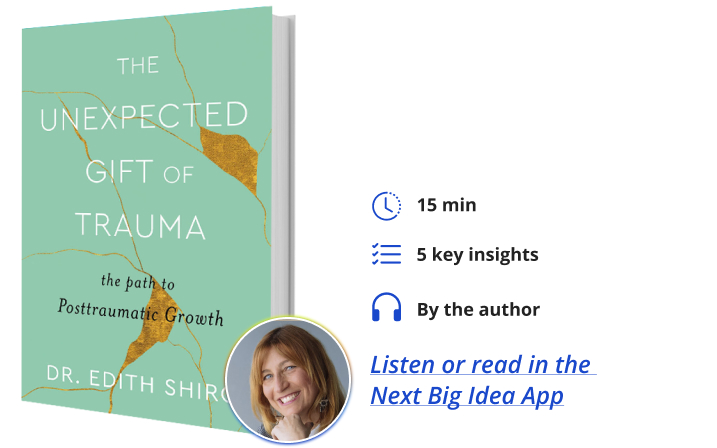Dr. Edith Shiro is a clinical psychologist who specializes in trauma and posttraumatic growth. Dr. Shiro is co-founder of the Trauma and Resilience Center, a board member of the World Happiness Foundation, and an active member of Cadena International, providing humanitarian aid and disaster prevention worldwide.
Below, Edith shares 5 key insights from her new book, The Unexpected Gift of Trauma: The Path to Posttraumatic Growth. Listen to the audio version—read by Edith herself—in the Next Big Idea App.

1. Trauma has the power to destroy and the power to transform.
Trauma has always been part of the human experience and sometimes it’s easy to identify. Simply read the daily news: massive earthquakes, floods, fires, and other natural disasters that kill thousands and displace thousands more; hate crimes, terrorist attacks, toxic spills in marginalized neighborhoods; the list goes on. Other times, it’s hidden behind closed doors: child abuse, domestic violence, poverty, and housing insecurity. Many experience it through microaggressions leveled at them because of their religion, ethnicity, gender, or sexual orientation. Trauma clearly has the capacity to destroy individual lives and even whole communities, upending everything we know to be true and leaving us with a sense of hopelessness and confusion. Yet, some people can go through a difficult experience and will not only survive but thrive. That is the paradox of trauma.
Until recently, issues related to mental health were stigmatized. The effects of trauma on people’s overall health and well-being weren’t really recognized as something relevant to talk about. It wasn’t until we were faced with situations that completely changed our environment, such as the global pandemic, war, repetitive school shootings, and natural disasters, that the word trauma began to resonate in people’s ears. If we decide to ignore it or pretend that it does not exist, trauma has the capacity to destroy us, paralyze us, affect each and every one of the environments in which we develop, isolate us, and change our way of living forever. But it can also be a tool that leads us toward transformation, growth, and a higher level of wisdom—this is called posttraumatic growth (PTG).
PTG is the positive psychological changes that people experience as a result of their struggles with highly challenging life circumstances. PTG is both a process of transformation and a potential outcome in the face of adversity.
The best way to illustrate this is through Bill. He was a firefighter in Lower Manhattan when the tragic terrorist event took place on September 11. He witnessed horrific scenes that left deep scars and completely traumatized him. This trauma affected not only him but also his relationship with his wife and daughters. He started drinking and hated going to work, denying something was wrong. One day, he found himself standing on the Washington Bridge about to end his life when he finally realized he needed help. After working in therapy and with the help of his support system, he went through the five stages of PTG and began to heal. Later, he chose to help the other firefighters who had gone through the same trauma and eventually created an expanded downtown community of support for all those professionals and neighborhoods that have lived through the horrors of 9/11.
“PTG is the positive psychological changes that people experience as a result of their struggles with highly challenging life circumstances.”
People who experience PTG see trauma and adversity as possibilities for transformation. They not only process what has happened to them and recover from it but their lives are enriched because of the experience. They are everyday heroes, and we see examples like them in the news all the time. People like Oprah, Malala Yousafzai, LeBron James, and Lady Gaga, have endured terrible suffering and yet they’ve gone on to name, heal, and integrate their past into their present lives, using what they’ve learned to ease the suffering of others.
2. From breakdowns to breakthroughs.
The process of PTG is hard; not everyone wants or even needs to do it. Some people remain stuck in post-traumatic stress disorder (PTSD), while others find a way to bounce back from adversity, put their experiences behind them, and get on with their lives. Those who are committed to the journey find that they not only heal but emerge stronger and more beautiful than ever—not in spite of what they’ve gone through, but because of it. I’ve seen this growth in those who have endured unspeakable acts of violence as well as others who have suffered, through the heartbreak of a painful divorce, a debilitating accident, the shame of being bullied, or the death of a child. Once hopeless and anxious, they have emerged empowered and confident, all of this continues to inspire a belief that trauma can be a springboard for radical transformation and emotional and spiritual growth—there is profound wisdom locked within our suffering, waiting to be revealed.
The perfect symbol for PTG comes from Kintsugi, the ancient Japanese art form of mending broken pottery. The goal in repairing a broken vase, for example, isn’t to hide the imperfections but to use lacquer mixed with powdered gold to enhance them and integrate them into something unique and often more beautiful than the original. The finished piece is an invitation to celebrate our uniqueness and our brokenness. We all have broken pieces within us, wounds that remind us of experiences we’d rather forget. As Leonard Cohen once wrote, “There is a crack in everything, that’s how the light gets in.” That is what PTG is all about, it allows you to hold the trauma and the healing at the same time. We’re not just repairing what’s broken; we’re creating a whole new story for ourselves.
There are five different stages that people invariably go through when going through trauma, managing to bring their state of pain and deep suffering to a state of happiness, wisdom, and growth. This five-stage process can serve as a roadmap toward helping people recognize when they’re stuck and how to navigate the process. Through this process, they can experience a sense of renewal and rebirth, and even a spiritual awakening. They provide a language to identify, define, express, and communicate the process of healing. The five stages serve to recognize milestones to measure progress, thereby overcoming hopelessness and despair. This approach works for collective, systemic, and cultural traumas as well as individual suffering. Think of the stages as a collective journey from which we emerge from isolation and paralysis, no longer disconnected and fragmented from ourselves and others. Together, we unlock our collective wisdom, bringing consciousness and transformation to all.
3. Trauma is contagious and so are wisdom and growth.
This is how it works: the generations that came before us passed it on to us, and then we unconsciously pass it along to our children. This goes on and on through our family lineage, our community, and our culture. Repetitive patterns, limiting beliefs, fears, wounds of rejection, discrimination, and abandonment, but it isn’t only the big, traumatic experiences from our past that get imprinted in our cellular memory. For example, your fear of water may have originated from the fact that your great-grandmother almost drowned and repeatedly impressed upon her children and grandchildren that pools were horrible, dangerous places. You inherited that fear without even knowing its origin.
“Sometimes you may not even realize how a traumatic experience has impacted you until you see how it’s affecting others.”
Research shows us that one person’s trauma can spread to their family members, to people they love, and to those with whom they share a cultural and historical ancestry. It can have far-reaching consequences for individuals, families, and communities. Sometimes you may not even realize how a traumatic experience has impacted you until you see how it’s affecting others.
Let’s talk about Pilar: she told me one day that she turned around to see her five-year-old daughter standing behind her and she froze. It suddenly hit her. She was sexually abused when she was her age. She is a survivor of sexual abuse. At that moment, she knew she not only had to accept that she was victimized, but that she had to take steps to heal, not only for her sake, but for her daughter’s, and even her daughter’s future children. By committing to PTG, we not only heal and transcend our own traumas, but we heal the traumas of our grandparents, great-grandparents, and on through the generations. When we do the work, we can hopefully say, “The trauma stops here.” We can say, “I refuse to pass along my suffering or the suffering I inherited to my children and grandchildren.” I am breaking the cycle of trauma.
It’s important to understand, of course, that trauma isn’t the only thing that gets passed on. When we go through PTG, not only do we change our lives for the better, but we change the lives of future generations. In healing our traumas, we not only heal the suffering of our ancestors, but we bring forth, and pass on, their wisdom, joys, strength, and beliefs that will sustain and enrich our lives.
4. To accept is to move forward.
So now the question is: how does the PTG process start? It has to begin with something called radical acceptance. This is when you are at the darkest, lowest place. As a patient once said, it is “a holy shit moment.” It’s that moment when you realize everything is out of control, you don’t know who you are, nothing makes sense, how things work, or even how to relate to others. You’ve hit rock bottom and cannot endure the pain; something needs to shift. It’s time to attend to the wounds buried deep within your being. It’s time to radically accept that these wounds, which may have originated from something that happened yesterday, last week, or many years ago, are very much alive in the present. Because here’s the thing: You cannot move forward until you do. In the words of Anais Nin, “The day came when the risk to remain in a bud was more painful than the risk it took to blossom.”
Oren is a great example of this. He loved to party hard, drink, do drugs, and stay out all night. He never really thought he had a problem, he was just having fun, until his best friend staged an intervention. Immediately after that, he went into a spiral of denial, blaming his friends for overreacting and abandoning him. Then one day he got into his car after an all-night bender, and ran it off the road, ending up with multiple injuries. Lying in the hospital, completely incapacitated, he got it. He was an addict and if he kept going this way, he was going to die.
“Sometimes, another event has to happen that brings that trauma back to awareness for it to finally become conscious.”
During the course of our lives, each person goes through circumstances that allow them to develop defense mechanisms to a greater or lesser degree. In moments of difficulty and great pain, these defense mechanisms help them survive adversity. These adaptive behaviors that make us dissociate, deny, or detach from the pain keep us functioning in ways in which we can continue to live without feeling the actual pain, loss, or suffering. Sometimes, another event has to happen that brings that trauma back to awareness for it to finally become conscious. Before we can heal, we first must accept that we are suffering, acknowledge there’s a cause of suffering, and recognize there is an end to it as well as a path to get us there, if we choose to take it. Radical acceptance is to accept what is happening to us in the moment, even when there are no words to describe it or give it a name yet. Radical acceptance is the beginning of the beautiful journey toward PTG.
5. Trust the process and stick with it.
PTG is not necessarily a natural process that occurs to everyone who comes to heal their traumas, nor does it erase the trauma. It does not happen in the same way for all people and it’s not an illusion. PTG is real and available to anyone, but it requires intention, determination, and a commitment of discipline and effort. It has its own timeline and cannot be rushed. The healing process takes courage, vulnerability, and a certain level of belief in the process.
Many people feel that the work they’ve done to transform their lives and transcend the pain of their past has forever changed them. They become more conscious, more awake, and more connected to everything around them. But then what? How can we stay elevated once we experience wisdom and growth? Or, are we done? Is it a permanent thing? Not exactly, life doesn’t work like that.
PTG doesn’t mean we won’t face new obstacles or, in facing them, we won’t be frightened, sad, or challenged. Suffering is part of the human experience, and nothing can shield us from future heartbreak. However, once we’ve gone through the process, we know that we are capable of facing adversity. Growth after trauma is possible. We have the tools we need to make it happen, and it’s worth the struggle to get there. Some of the ways we keep healing and transforming are to stay connected to our bodies and our minds through movement and meditation; to nurture relationships; to express ourselves in creative ways through art, music, writing, and dancing; to experience nature; to have a sense of belonging to our communities where we can be of service and become a voice of healing for others.
When you are willing to do the work and show up fully committed, posttraumatic growth offers a way to a richer, more connected life, not in spite of what you’ve gone through, but because of it. Healing cannot happen overnight; it might come quickly for some people while others will find themselves stuck in a stage for quite a long time. Sometimes it will feel like you will never be able to see the light at the end of the tunnel, but you will, all you need to do is trust the process and take the time you need to heal and advance at your own pace. It will take working with your therapist, facilitator, or mentor, and having the support of your family, friends, and community. Most importantly, you must be willing to dive into the fire, burn away the wounds of the trauma, and be reborn. As Haruki Murakami said, “When you come out of the storm, you won’t be the same person who walked in; that’s what this storm is all about.”
To listen to the audio version read by author Edith Shiro, download the Next Big Idea App today:































